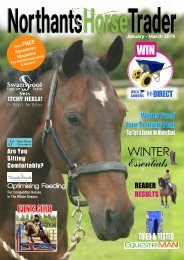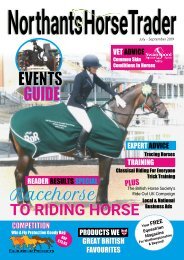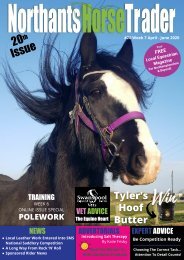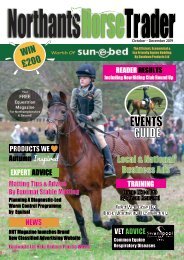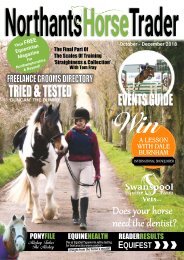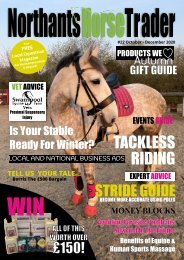NHT Magazine Spring 2018
Create successful ePaper yourself
Turn your PDF publications into a flip-book with our unique Google optimized e-Paper software.
The<br />
Scales<br />
Of<br />
Training<br />
An Introduction<br />
To Rhythm<br />
& Suppleness<br />
With Tom Fray<br />
One of the biggest challenges<br />
facing most riders is working<br />
out what to do when you ride<br />
in the school. Whatever your<br />
chosen discipline there are<br />
some fundamentals of training<br />
horses that will help you to<br />
improve your horse’s way of<br />
going and give you a<br />
framework to base your<br />
schooling on.<br />
The scales of training are a<br />
process you should follow to<br />
train your horse in the short<br />
and long term. You should<br />
consider the progressive<br />
scales every time you ride<br />
and develop the elements<br />
over the life of the horses<br />
training. You need to ensure<br />
you achieve each one before<br />
moving on to the next.<br />
The Scales are:<br />
1. Rhythm<br />
2. Suppleness<br />
3. Contact<br />
4. Impulsion<br />
5. Straightness<br />
6. Collection<br />
Consider a newly backed 4 year old being ridden<br />
away; in the beginning there is little chance of<br />
suppleness let alone impulsion or straightness.<br />
Your key focus should be on establishing rhythm,<br />
which can be described as the ‘regularity of the<br />
beat’.<br />
Unridden, a youngster will happily trot around the<br />
field in perfect rhythm; rhythm is efficient and<br />
therefore saves energy which is essential for<br />
survival in the wild. Introduce a rider and all of a<br />
sudden he has to balance himself in a completely<br />
different way, he will lose his balance and also<br />
rhythm. He must be given time to re-balance<br />
himself, build strength and find his natural<br />
rhythm. Your job as a rider is to stay in balance<br />
to allow the horse to find his balance. It is so<br />
important that youngsters are taught to move<br />
freely forward to help develop independence,<br />
confidence, balance and strength. Think how it<br />
may be best to achieve this, hacking out and<br />
showing him the world will have a greater effect<br />
on this than constant circles in an arena.<br />
As his confidence and balance improves, he will<br />
find his rhythm and start to build his strength, you<br />
can then start to think about suppleness.<br />
What is suppleness?<br />
There is a difference between suppleness and<br />
flexibility. Flexibility is the range of movement,<br />
suppleness is the ease of the movement.<br />
Imagine we have two identical hinges, but one is<br />
rusty. They both have the same range of<br />
movement but the rusty one is less easy to open<br />
and close. Both hinges have the same amount of<br />
flexibility; the non-rusty hinge is more supple than<br />
the rusty one. Suppleness in horses can be<br />
thought of in two directions, lateral (sideways)<br />
and longitudinal (lengthways), both can be<br />
11<br />
developed together. As you embark on teaching<br />
your horse rhythm and suppleness under saddle<br />
it is essential that he understand your aids. He<br />
needs to know that when you nudge him with<br />
your heel you are asking for increased activity<br />
from the hind-leg, either in a forwards or<br />
sideways direction. He needs to know that when<br />
you close your fingers around the rein and apply<br />
pressure to his mouth through the bit he should<br />
yield to that pressure.<br />
Let’s think for a moment about the relationship<br />
between the aids and the response. If a fly lands<br />
on your horse while he is out grazing in the warm<br />
sunshine what does he do? He will twitch his skin<br />
or swish his tail. He felt the fly and reacted; what<br />
does he do when you apply a leg aid? He can<br />
certainly feel your leg, but does he react to your<br />
leg? How will you improve his reaction to your<br />
leg? This is where training horses actually<br />
becomes simple, providing you keep it simple!<br />
Horses are creatures of habit and become a<br />
direct reflection of their environment and<br />
experiences. So, if every time you nudge him<br />
with your leg and he does not respond how you<br />
want him to and you do nothing to change it then<br />
it will never change. You are effectively training<br />
him to be unresponsive to the leg.<br />
You are training your horse all the time you are<br />
with him, training is not reserved for your<br />
schooling sessions or lessons, your horse does<br />
not know the difference, he is simply becoming<br />
the product of his experiences. If you want him to<br />
become sharper to the leg aid then you need to<br />
be very consistent and clear in your expectations.<br />
You must ask in the same way every time you<br />
ask, you must back the aid up with an artificial<br />
aid if required in order to sharpen the reaction to<br />
the aid. This is the key message here, you need<br />
to sharpen his REACTION to the aid, not<br />
sharpen the aid. Simply put, you must ensure<br />
when you put your leg on the horse moves<br />
quickly from that aid; if he doesn’t you back it up<br />
with a sharper leg aid, voice or the crop. You<br />
then repeat the transition with the original aid you<br />
are aiming to achieve and reward the horse if he<br />
does it well; or back it up again if he does not.<br />
Keep repeating this until you have achieved a<br />
sharper reaction to the original aid. It is important<br />
that whilst working through this exercise you<br />
focus on the simple lesson you are teaching him,<br />
which is to improve his reaction to your leg. So<br />
you might forgive him if goes a bit hollow at the<br />
beginning providing he is improving his reaction<br />
to the leg. Keeping him round at the same time<br />
may become confusing for him. Once you have<br />
taught him to move forward from the leg you will<br />
be able to develop a more supple horse and<br />
improved contact and therefore stay rounder<br />
through the transition.<br />
Here you will see that I have alluded to the third<br />
‘scale’ on the scales of training and can hopefully<br />
appreciate the value of developing each scale<br />
progressively. Work firstly on rhythm, develop<br />
suppleness and the contact will follow.<br />
Likewise, if you have a horse that is over-reactive<br />
to the leg then you must ensure your leg is<br />
consistently around the horse; you must give him<br />
confidence that your leg will always be in the<br />
same place and will always be there, he will learn<br />
to accept the leg and eventually soften to it. From<br />
there you will be able to train him to be<br />
reasonable in his reaction to your leg. Horses like<br />
routine and dislike surprises, so if your leg is a<br />
constant in his life he will accept it; if it is<br />
inconsistent and makes him jump then he will<br />
struggle to understand and accept it.





